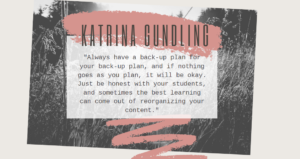
I Am Not a Robot
When students enroll in online classes, they are often wary and a bit intimidated by the experience. There are a multitude of concerns such as

When students enroll in online classes, they are often wary and a bit intimidated by the experience. There are a multitude of concerns such as

Regardless of whether you’ve been teaching for 15 years or 15 minutes, how to act and what to do on the first day of class

The Focus is You will now occur just once a month. We have other exciting things to share with you on Thursdays, like our new,

A bunch of guys had a late afternoon game of touch football in a field. As it started getting dark and the players moved toward

In the face-to-face classroom, each faculty member typically designs and teaches their own course with minimal input from departmental colleagues. Reflective of this approach, many

One of the most intriguing, and perhaps intimidating, aspects of walking into a class for the first time and introducing yourself is deciding who you

There’s no discounting the importance of the first day of class. What happens that day sets the tone for the rest of the course. Outlined

A very short trip to a time long ago J. R. R. Tolkien’s famous 1937 fantasy book, The Hobbit, introduces among its heroes a fierce

As faculty, we want our students to achieve, but more than that we want our students to see, at least in some way, that what

To: My Students From: Your Teacher Re: What’s happening in college—is it real? I just read about a senior engineering student who was presenting a
Get exclusive access to programs, reports, podcast episodes, articles, and more!